What's The Best Method For Cleaning Baby Bok Choy?

Baby bok choy is a nutrient-dense and delicious leafy green vegetable with dozens of applications. But like every great veggie, baby bok choy should be cleaned before consumption.
Baby boy choy is grown in soil, and as much as we love natural foods plucked straight from the ground, fresh produce often retains the dirt it was grown in long after it's been distributed to your local supermarket. Not only is baby bok choy susceptible to soil residue, but it can also hide insects in its leaves. Plus, bok choy is a hot spot for veggie-eating slugs and snails, and it's safe to say that no one wants their vegetable platter tainted with a snail trail.
The best way to clean your baby bok choy doesn't require vegetable wash or a fancy desensitizing concoction, all you need is a knife, a bowl, and fresh water. Before you get to washing the baby bok choy, cut it vertically in half. This exposes the inner surfaces and reveals contaminants that may be hiding in places unseen. Then you'll want to fill a bowl with fresh water and swish the produce around, changing the water three times to ensure that you're not washing the bok choy in dirty water. Finally, give it a pulse in a salad spinner before cooking to remove excess liquid. If you don't have a salad spinner, air drying or patting down with paper products or a towel will do the trick.
Read more: 12 Vegetables And Fruits That Used To Look Very Different
Baby Bok Choy Cleaning Faux Pas

We'll be the first to say that food poisoning and consuming dirty produce is worth the concern. However, washing and cleaning your baby bok choy is as simple as eating it, so there's no need to overcomplicate it. Sure, expensive veggie wash, lightly salted water, and vinegar-water solutions can clean your produce well, but good old-fashioned tap water will take care of washing away any impurities, debris, pesticides, and tiny little pests that might be stuck to your baby bok choy. Whichever way you choose to wash it, there are some cleaning methods you should always avoid.
Never use dish soap or any household detergent to clean your vegetables as they can leave residues or chemicals on the surface, making them unsafe for consumption. Using bleach or other harsh chemicals is not only unnecessary but also dangerous -- these substances can be harmful if ingested and should never come into contact with your fresh produce. While scrubbing with a vegetable brush or gentle handling is a great way to get rid of any funk on your produce, excessive scrubbing can damage the delicate leaves and stems of baby bok choy, damaging its texture and appearance.
Picking Healthy Baby Bok Choy And Preservation

Before the cleaning and cooking process even begins, you'll want to select a head of baby bok choy that's fresh and doesn't require extensive cleaning and maintenance. Look for baby bok choy with crisp, vibrant, and deeply green leaves that are well-structured rather than wilted. Always avoid purchasing baby bok choy that emits a foul odor, as this can indicate spoilage. Not only should you inspect its color and texture, but you should also keep an eye out for any holes in its leaves as this indicates the presence of veggie-eating pests.
When it comes to storing and maintaining the freshness of your baby bok choy, it can be refrigerated for up to seven days when stored in a breathable bag. If you're storing it next to other fruits and vegetables, make sure that you've thoroughly cleaned its neighboring produce to avoid tainting the freshly washed baby bok choy with dirt or bugs from other food products.
Once you've washed your baby bok choy, you won't have to wash it again after storing it in the refrigerator, however, it doesn't hurt to give it another rinse.
Read the original article on Daily Meal.

